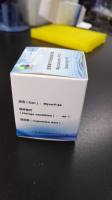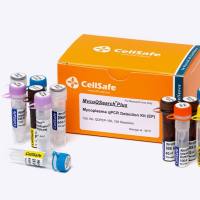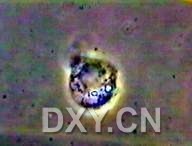支原体污染的不同处理方法对比
互联网
Presentation at the World Veterinary Poultry Association, Cairo, Egypt, January 2002 p.200
Introduction:
Mycoplasma infection continues to be an important cause of loss in poultry production. Kleven (1990) described the losses due to Mycoplasma gallisepticum (MG). These were a reduction in egg production of 10-20%, an increase in embryo mortality and chick mortality of 5-10% and a reduction in weight gain and feed conversion efficiency of 10-20%. In spite of the availability of vaccines, antimicrobial use continues to be the most economic method (Stipkovits et al, 1993) of controlling these infections, where the diseases are still endemic.
As a result, resistance has developed to a number of antimicrobials and the purpose of this paper is to review the activity of tiamulin and several antimicrobials against a number of common pathogenic poultry mycoplasma, MG, M. synoviae (MS), M. meleagridis (MM) and M. iowae (MI) and compare their resistance development over the last 25 years.
Materials and Methods:
A search of published literature was carried out and these data was combined with our own internal reports. A total of 20 references were compiled. Reports from 1975-1989 and from 1990-2000 were compared. The ranges of minimum inhibitory concentrations (MICs) of various antimicrobials against various mycoplasma species were entered into a database. The maximum and minimum data for each time period were compared for tiamulin, tylosin, oxytetracycline, lincomycin and enrofloxacin.
Results:
From the 20 references and reports, 13 were from before 1990 and seven from 1990 and after. There was information on 241 isolates of MG, 105 of MS, 28 of MM and 111 of MI. The comparative data for the four mycoplasma species are summarized in the tables below.
<center> <p> Table 1. <i>Mycoplasma gallisepticum</i> , MIC ranges (µg/ml) by time period (no. of isolates)</p> <table> <tbody> <tr> <td> <p class="MsoNormal"> <b><span>Antimicrobial</span> </b></p> </td> <td> <p class="MsoNormal"> <b><span>1975-1989 (175)</span> </b></p> </td> <td> <p class="MsoNormal"> <b><span>1990-2000 (66)</span> </b></p> </td> </tr> <tr> <td> <p class="MsoNormal"> <span>Tiamulin</span></p> </td> <td> <p class="MsoNormal"> <span>0.0039-0.78</span></p> </td> <td> <p class="MsoNormal"> <span>0.006-0.39</span></p> </td> </tr> <tr> <td> <p class="MsoNormal"> <span>Tylosin</span></p> </td> <td> <p class="MsoNormal"> <span>0.01-75</span></p> </td> <td> <p class="MsoNormal"> <span>0.006-400</span></p> </td> </tr> <tr> <td> <p class="MsoNormal"> <span>Oxytetracycline</span></p> </td> <td> <p class="MsoNormal"> <span>0.12-10</span></p> </td> <td> <p class="MsoNormal"> <span>0.05-200</span></p> </td> </tr> <tr> <td> <p class="MsoNormal"> <span>Lincomycin</span></p> </td> <td> <p class="MsoNormal"> <span>0.4-64</span></p> </td> <td> <p class="MsoNormal"> <span>0.125-6.25</span></p> </td> </tr> <tr> <td> <p class="MsoNormal"> <span>Enrofloxacin</span></p> </td> <td> <p class="MsoNormal"> <span>0.01-0.25</span></p> </td> <td> <p class="MsoNormal"> <span>0.0125-2.0</span></p> </td> </tr> </tbody> </table> <p> </p> <p> Table 2. <i>Mycoplasma synoviae</i> , MIC ranges (µg/ml) by time period (no. of isolates)</p> <table> <tbody> <tr> <td> <p class="MsoNormal"> <b><span>Antimicrobial</span> </b></p> </td> <td> <p class="MsoNormal"> <b><span>1975-1989 (53)</span> </b></p> </td> <td> <p class="MsoNormal"> <b><span>1990-2000 (52)</span> </b></p> </td> </tr> <tr> <td> <p class="MsoNormal"> <span>Tiamulin</span></p> </td> <td> <p class="MsoNormal"> <span>0.031-1.0</span></p> </td> <td> <p class="MsoNormal"> <span>0.006-0.5</span></p> </td> </tr> <tr> <td> <p class="MsoNormal"> <span>Tylosin</span></p> </td> <td> <p class="MsoNormal"> <span>0.015-75</span></p> </td> <td> <p class="MsoNormal"> <span>0.006-50</span></p> </td> </tr> <tr> <td> <p class="MsoNormal"> <span>Oxytetracycline</span></p> </td> <td> <p class="MsoNormal"> <span>0.06-0.08</span></p> </td> <td> <p class="MsoNormal"> <span>0.025-100</span></p> </td> </tr> <tr> <td> <p class="MsoNormal"> <span>Lincomycin</span></p> </td> <td> <p class="MsoNormal"> <span>0.31-6.0</span></p> </td> <td> <p class="MsoNormal"> <span>0.05-1.56</span></p> </td> </tr> <tr> <td> <p class="MsoNormal"> <span>Enrofloxacin</span></p> </td> <td> <p class="MsoNormal"> <span>0.1-1.0</span></p> </td> <td> <p class="MsoNormal"> <span>0.025-1.56</span></p> </td> </tr> </tbody> </table> <p> </p> <p> Table 3. <i>Mycoplasma meleagridis</i> , MIC ranges (µg/ml) by time period (no. of isolates)<br /> </p> <table> <tbody> <tr> <td> <p class="MsoNormal"> <b><span>Antimicrobial</span> </b></p> </td> <td> <p class="MsoNormal"> <b><span>1975-1989 (17)</span> </b></p> </td> <td> <p class="MsoNormal"> <b><span>1990-2000 (11)</span> </b></p> </td> </tr> <tr> <td> <p class="MsoNormal"> <span>Tiamulin</span></p> </td> <td> <p class="MsoNormal"> <span>0.03-1.0</span></p> </td> <td> <p class="MsoNormal"> <span>0.025-3.13</span></p> </td> </tr> <tr> <td> <p class="MsoNormal"> <span>Tylosin</span></p> </td> <td> <p class="MsoNormal"> <span>0.015-3.0</span></p> </td> <td> <p class="MsoNormal"> <span>0.78-50</span></p> </td> </tr> <tr> <td> <p class="MsoNormal"> <span>Oxytetracycline</span></p> </td> <td> <p class="MsoNormal"> <span>0.3-5.0</span></p> </td> <td> <p class="MsoNormal"> <span>0.05-25</span></p> </td> </tr> <tr> <td> <p class="MsoNormal"> <span>Lincomycin</span></p> </td> <td> <p class="MsoNormal"> <span>0.5-5.0</span></p> </td> <td> <p class="MsoNormal"> <span>0.05-25</span></p> </td> </tr> <tr> <td> <p class="MsoNormal"> <span>Enrofloxacin</span></p> </td> <td> <p class="MsoNormal"> <span>0.015-1.0</span></p> </td> <td> <p class="MsoNormal"> <span>0.1-3.13</span></p> </td> </tr> </tbody> </table> <p> </p> <p> Table 4. <i>Mycoplasma iowae</i> , MIC ranges (µg/ml) by time period (no. of isolates)</p> <table> <tbody> <tr> <td> <p class="MsoNormal"> <b><span>Antimicrobial</span> </b></p> </td> <td> <p class="MsoNormal"> <b><span>1975-1989 (25)</span> </b></p> </td> <td> <p class="MsoNormal"> <b><span>1990-2000 (86)</span> </b></p> </td> </tr> <tr> <td> <p class="MsoNormal"> <span>Tiamulin</span></p> </td> <td> <p class="MsoNormal"> <span>0.015-10</span></p> </td> <td> <p class="MsoNormal"> <span>0.006-0.125</span></p> </td> </tr> <tr> <td> <p class="MsoNormal"> <span>Tylosin</span></p> </td> <td> <p class="MsoNormal"> <span>0.05-64</span></p> </td> <td> <p class="MsoNormal"> <span>0.05-100</span></p> </td> </tr> <tr> <td> <p class="MsoNormal"> <span>Oxytetracycline</span></p> </td> <td> <p class="MsoNormal"> <span>1-3</span></p> </td> <td> <p class="MsoNormal"> <span>0.025-100</span></p> </td> </tr> <tr> <td> <p class="MsoNormal"> <span>Lincomycin</span></p> </td> <td> <p class="MsoNormal"> <span>3-64</span></p> </td> <td> <p class="MsoNormal"> <span>0.05-100</span></p> </td> </tr> <tr> <td> <p class="MsoNormal"> <span>Enrofloxacin</span></p> </td> <td> <p class="MsoNormal"> <span>0.1-1.0</span></p> </td> <td> <p class="MsoNormal"> <span>0.005-1.0</span></p> </td> </tr> </tbody> </table> </center>
Conclusions:
MG has shown no resistance development to tiamulin over the last 25 years and all 241 isolates could be considered sensitive. In contrast there is resistance development to tylosin, oxytetracycline, lincomycin and borderline resistance to enrofloxacin and this appears to have increased in the last decade.
MS has shown no increase in resistance to tiamulin and almost all of the 105 isolates would be considered sensitive. In contrast, resistance has developed to tylosin and oxytetracycline. Levels of resistance to lincomycin remain low and all strains could be considered sensitive to enrofloxacin.
MM isolates (28) from turkeys show some resistance to tiamulin and enrofloxacin. However, tylosin, oxytetracycline and lincomycin show a marked increase in resistance development.
MI has developed almost no resistance to tiamulin and enrofloxacin. In the nineties all isolates would be considered sensitive. High levels of resistance have developed to tylosin, oxytetracycline and lincomycin.
These findings confirm those of Drews and others (1975) and Stipkovits and Burch (1993) that tiamulin is a low inducer of resistance in mycoplasma in comparison with tylosin and slower than oxytetracycline and enrofloxacin (Stipkovits and Burch, 1993) as resistance has not developed with long-term use. Furthermore, the highest MIC level of tiamulin against MG in recent years is 16 times lower than that of lincomycin.
In conclusion, tiamulin could be considered a highly effective therapeutic in mycoplasma control programs for both chickens and turkeys.
References:
Drews, J. Georgopolous, A., Laber, G., Schütze, E. and Unger, J. (1975) Antimicrobial activities of 81.723 hfu, a new pleuromutilin derivative. Antimicrobial Agents and Chemotherapy, 2, 5, pp 507-516
Kleven, S.H. (1990) Summary of discussions of avian mycoplasma team. Avian Pathology, 19, pp 795-800
Stipkovits, L. and Burch, D.G.S. (1993) Antibiotic resistance of mycoplasmas of chickens and turkey origin. Proceedings Xth World Veterinary Poultry Association Congress, Sydney , p179, Abst 121
Stipkovits, L., Laber, G. and Burch, D.G.S. (1993) Comparative studies on efficacy of MG bacterin and tiamulin treatment of breeder layers. Proceedings Xth World Veterinary Poultry Association Congress, Sydney , p155, Abst 40
Database references:
Drews, J. Georgopolous, A., Laber, G., Schütze, E. and Unger, J. (1975) Antimicrobial activities of 81.723 hfu, a new pleuromutilin derivative. Antimicrobial Agents and Chemotherapy, 2, 5, pp507-516
Ziv, G. (1980) Preliminary clinical pharmacology investigations of tylosin and tiamulin in chickens. The Veterinary Quarterly, 2, 4, pp206-210
Forster, T.C., Ridgeway, E.J. and Baines, S. (1982) In vitro studies on tiamulin and kitasamycin against a range of organisms including pig pathogens. Proceedings of the International Pig Veterinary Society, Mexico City , p284
Burch, D.G.S. and Stipkovits, L. (1993) Enhancement effect of tiamulin and chlortetracycline or tiamulin and doxycycline combinations against mycoplasmas. Proceedings of the Xth World Poultry Association Congress, Sydney, p167, 88
Hinz, K.H. (1980) In vitro sensitivity of Mycoplasma gallisepticum field strains to tiamulin and tylosin. Deutsche Tierärztliche Wochenschrift 87, pp220-223
Grant, M. (1980) Report to E.R. Squibb and Sons ‘Sensitivity of Mycoplasma meleagridis and Mycoplasma iowae’
Levisohn, S. (1981) Antibiotic sensitivity patterns in field isolates of Mycoplasma gallisepticum as a guide to chemotherapy. Israeli Journal of Medical Science, 17, pp661-666
Bowtell, D. and Whithear, K. (1981) Report to E.R. Squibb and Sons ‘A survey of the antibiotic sensitivity of Australian isolates of Mycoplasma gallisepticum, Mycoplasma synoviae and Mycoplasma pulmonis’
Whithear, K.G., Bowtell, D.D., Ghiocas, E. and Hughes, K.L. (1983) Evaluation and use of a micro-broth dilution procedure for testing sensitivity of fermentative avian mycoplasmas to antibiotics. Avian Diseases 27, 4, pp937-949
Baxter-Jones, C. (1984) Report to E.R. Squibb and Sons ‘Sensitivity of M. synoviae’
Jordan , F.T.W. and Knight, D. (1984) The minimum inhibitory concentration of kitasmycin, tylosin and tiamulin for Mycoplasma gallisepticum and their protective effect on infected chicks. Avian Pathology, 13 pp151-162
Lin, M.Y. (1987) In vitro comparison of the activity of various antibiotics and drugs against new Taiwan isolates and standard strains of avian mycoplasmas. Avian Diseases. 31, pp705-712
Kempf, I. , Ollivier, C., Hospitalier, R., Guittet, M. and Bennejean, G. (1989) Concentrations minimales inhibitrices de 13 antibiotiques vis-a-vis de 21 souches de mycoplasmas des volailles. Le Point Vétérinaire, 20, 118, pp83-88
Takahata, T. and others (1992) Proceedings of the 19th World’s Poultry Congress, Amsterdam , Poster presentation
Koh, H.B., Kang, M.I. and Kim, G.N. (1993) Antimicrobial drug susceptibility of Mycoplasma gallisepticum isolated from the case of chronic respiratory disease outbreaks. Korean Journal of Veterinary Public Health, 17, 1, pp63-68
Stipkovits, L. and Burch, D.G.S. (1993) Antibiotic resistance of mycoplasmas of chickens and turkey origin. Proceedings Xth World Veterinary Poultry Association Congress, Sydney, pp17, 9, 121
Hannan, P.C.T., Windsor , G.D. de Jong, A., Schmeer, N. and Stegeman, M. (1997) Comparative susceptibilities of various animal-pathogenic mycoplasmas to fluoroquinolones. Antimicrobial Agents and Chemotherapy, 41, 9, pp2037-2040
Stipkovits, L. (1998) Report to Biochemie ‘Comparative in vitro studies of the efficacy of antibiotics against freshly isolated Mycoplasma iowae strains isolated from turkeys’
Jordan , F.T.W., Forrester , C.A. , Ripley, P.H. and Burch, D.G.S. (1998) In vitro and in vivo comparisons of valnemulin, tiamulin, enrofloxacin and lincomycin/spectinomycin against Mycoplasma gallisepticum. Avian Diseases. 42, pp738-745
Gautier-Bouchardon, A.V. Boscher, L., Kempt, I. and Kobisch, M. (1999) Concentrations minimales inhibitrice de 6 antibiotiques vis-a-vis 15 souches de mycoplasmes aviaires. La Recherche Avicole, St. Malo, 23-25 Mars 1999





